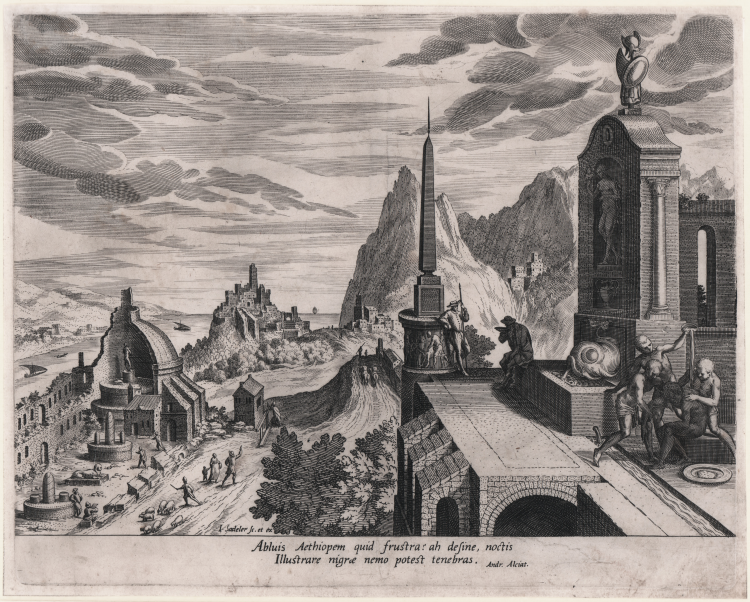



| Reference: | S13105 |
| Author | Johannes SADELER I |
| Year: | 1599 ca. |
| Measures: | 269 x 215 mm |



| Reference: | S13105 |
| Author | Johannes SADELER I |
| Year: | 1599 ca. |
| Measures: | 269 x 215 mm |
Engraving, 1599 approx, signed on lower centre.
After a subject by Hendrick van Cleve. Sole state.
Excellent work, printed on contemporary laid paper with “crown” watermark, thin margins, small abrasions on lower right corner, in general in good condition.
|
Hollstein 581.
|
Johannes SADELER I (Brussel 1550 - Venezia 1600 circa)
|
The SADELER: Flemish family of artists, active throughout Europe. For three generations this family of engravers, publishers and print-sellers played a dominant role in European graphic art, producing work of great variety and high quality. They were descended from a line of steel-chisellers from Aalst . Jan de Saeyelleer (Sadeleer) had three sons, Jan Sadeler I, Aegidius Sadeler I and Raphael Sadeler I, the first generation of engravers, publishers and print-sellers. The religious and political uncertainties of the time forced them to emigrate, and they worked in Cologne, Frankfurt am Main, Munich, Venice and Prague. The next generation followed in their footsteps, of whom Aegidius Sadeler II, who worked for Rudolf II and his successors, was the most notable. Justus Sadeler, the son of Jan Sadeler I, and the three sons of Raphael Sadeler I—Jan Sadeler II, Raphael Sadeler II and Filips Sadeler—were lesser artists but continued the family tradition. The third generation was represented by Tobias Sadeler (fl Vienna, 1670–75), son of Aegidius Sadeler II; he executed engravings for topographical books. JAN SADELER I: Draughtsman, engraver and publisher. He began work as a steel-chiseller or damascener but moved to Antwerp, where he was admitted to the Guild of St Luke in 1572 as a copperplate engraver. It was probably through Christoph Plantin’s publishing house that Jan came into contact with members of the Dutch Reformed Church with which he had close links. Jan engraved illustrations for Plantin (e.g. for the ‘Humanae salutatis monumenta’ of Arias Montanus, 1571, after drawings by Crispijn van den Broeck). It was probably in Antwerp also that he met Marten de Vos, with whom he and his brothers collaborated for many years. However, during his Antwerp years Jan engraved principally after the works of van den Broeck and Michiel Coxcie.
|
|
Hollstein 581.
|
Johannes SADELER I (Brussel 1550 - Venezia 1600 circa)
|
The SADELER: Flemish family of artists, active throughout Europe. For three generations this family of engravers, publishers and print-sellers played a dominant role in European graphic art, producing work of great variety and high quality. They were descended from a line of steel-chisellers from Aalst . Jan de Saeyelleer (Sadeleer) had three sons, Jan Sadeler I, Aegidius Sadeler I and Raphael Sadeler I, the first generation of engravers, publishers and print-sellers. The religious and political uncertainties of the time forced them to emigrate, and they worked in Cologne, Frankfurt am Main, Munich, Venice and Prague. The next generation followed in their footsteps, of whom Aegidius Sadeler II, who worked for Rudolf II and his successors, was the most notable. Justus Sadeler, the son of Jan Sadeler I, and the three sons of Raphael Sadeler I—Jan Sadeler II, Raphael Sadeler II and Filips Sadeler—were lesser artists but continued the family tradition. The third generation was represented by Tobias Sadeler (fl Vienna, 1670–75), son of Aegidius Sadeler II; he executed engravings for topographical books. JAN SADELER I: Draughtsman, engraver and publisher. He began work as a steel-chiseller or damascener but moved to Antwerp, where he was admitted to the Guild of St Luke in 1572 as a copperplate engraver. It was probably through Christoph Plantin’s publishing house that Jan came into contact with members of the Dutch Reformed Church with which he had close links. Jan engraved illustrations for Plantin (e.g. for the ‘Humanae salutatis monumenta’ of Arias Montanus, 1571, after drawings by Crispijn van den Broeck). It was probably in Antwerp also that he met Marten de Vos, with whom he and his brothers collaborated for many years. However, during his Antwerp years Jan engraved principally after the works of van den Broeck and Michiel Coxcie.
|